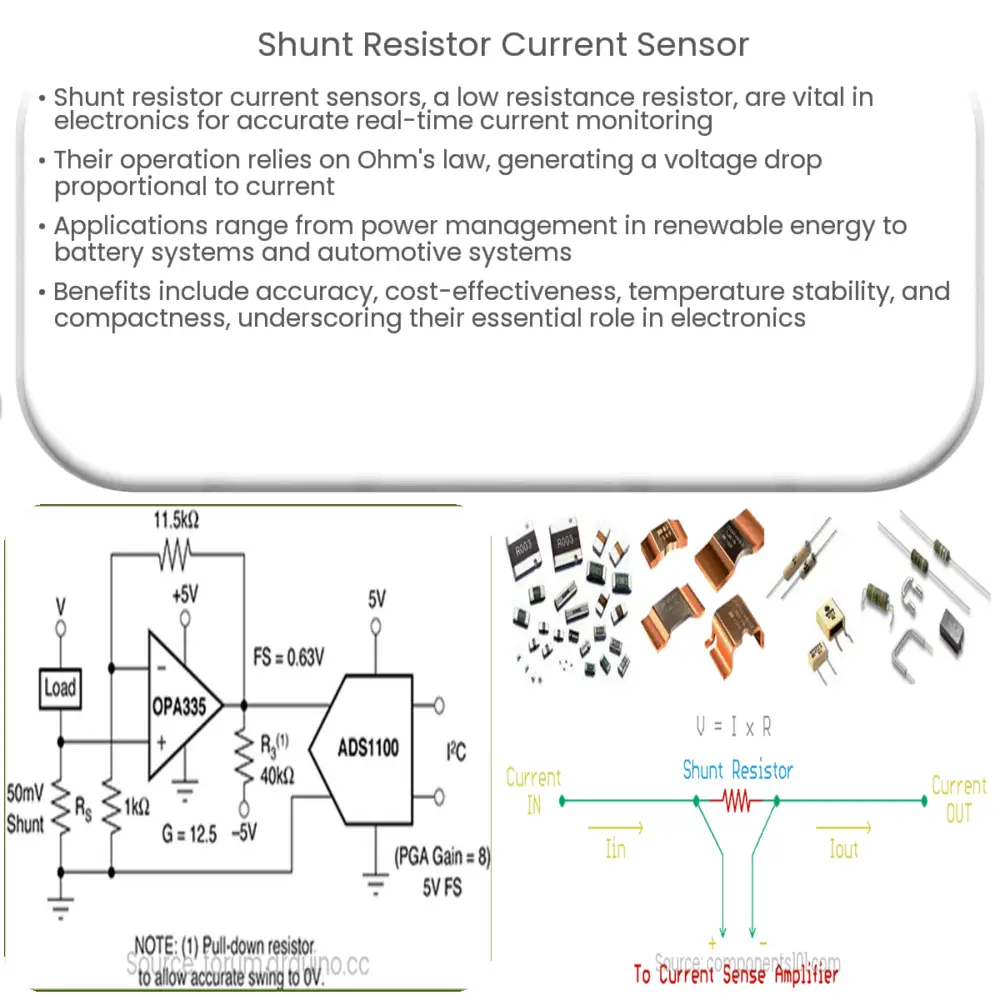Explore the fundamentals of shunt resistor current sensors, their working principle, applications, advantages, and their critical role in electronics.

Introduction to Shunt Resistor Current Sensors
Current sensing is a fundamental requirement in a wide range of electronic applications. From power supply and control circuitry to safety systems, understanding and monitoring the flow of current is essential. In this realm, shunt resistor current sensors play a pivotal role. This article aims to provide an in-depth understanding of these invaluable components.
What is a Shunt Resistor?
At its most basic level, a shunt resistor, often simply referred to as a shunt, is a device that allows electric current to pass around another point in the circuit. The term ‘shunt’ means to turn away or divert. In an electrical circuit, a shunt resistor is a low resistance resistor used to divert a portion of the electric current.
Shunt resistors are precisely calibrated for a specific resistance value. Ohm’s law, which states that the current through a conductor between two points is directly proportional to the voltage across the two points, provides the underlying theory of operation. In the case of a shunt resistor, this translates to the generation of a voltage drop proportional to the current.
Working of a Shunt Resistor Current Sensor
- Current Diversion: When placed in a circuit, the shunt resistor diverts a certain portion of the current. Its low resistance value minimizes any significant impact on the overall circuit performance.
- Voltage Measurement: The diverted current, passing through the shunt resistor, creates a voltage drop. This is directly proportional to the amount of current flowing.
- Current Calculation: The known resistance of the shunt resistor, along with the measured voltage drop, allows for the calculation of the current, using Ohm’s law (I = V/R).
In this way, shunt resistor current sensors provide a simple yet effective method for real-time current monitoring in an array of electronic systems. With this foundation, it is essential to consider the practical applications and advantages that these devices offer.
Applications of Shunt Resistor Current Sensors
Shunt resistor current sensors find utility in various applications across diverse domains. Here are a few key areas:
- Power Management: They are integral to power management systems, particularly in renewable energy installations such as solar panels or wind turbines, where monitoring and controlling current is critical for optimizing performance and longevity.
- Battery Systems: Battery management systems use shunt resistors for charge and discharge monitoring, crucial for preventing overcharging or deep discharge scenarios that could potentially damage the batteries.
- Automotive Systems: In electric vehicles, shunt resistors help in monitoring the current of the motor control circuit and battery systems. They also assist in controlling power distribution and in diagnostic functions.
- Industrial Automation: In industrial control systems, they aid in motor control, drive circuits, and power supplies where precise current monitoring helps maintain efficiency and safety.
Advantages of Shunt Resistor Current Sensors
Shunt resistor current sensors bring several benefits:
- Accuracy: These devices offer a high level of accuracy in current measurement, which is essential for the efficient operation of electronic systems.
- Cost-effectiveness: Compared to other current sensing technologies, shunt resistors are generally more cost-effective, making them a popular choice for many applications.
- Temperature Stability: Shunt resistors have excellent temperature stability, making them suitable for environments with wide temperature ranges.
- Compactness: They are typically small in size, which makes them easy to incorporate into electronic designs.
Conclusion
In conclusion, shunt resistor current sensors are an indispensable component in the design and operation of many electronic systems. By providing accurate, real-time current measurements, they enable system optimization, enhance safety, and contribute to the overall performance of a device. Their versatility and practical benefits ensure that they will continue to play a critical role in the field of electronics and beyond. Indeed, as technologies continue to evolve and the need for effective power management becomes ever more paramount, the relevance and value of shunt resistor current sensors cannot be understated.

